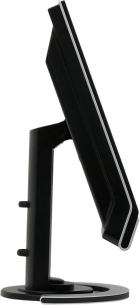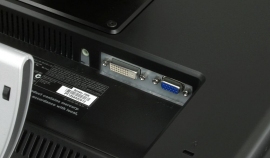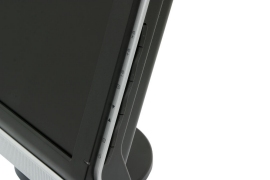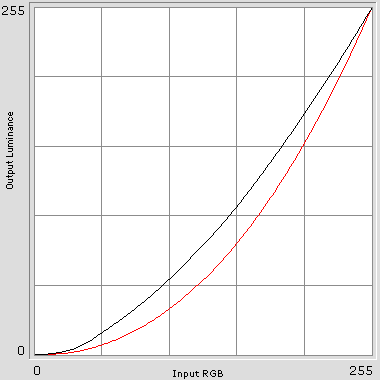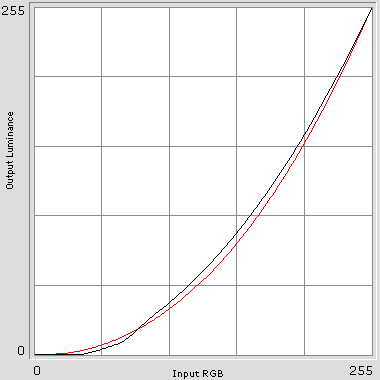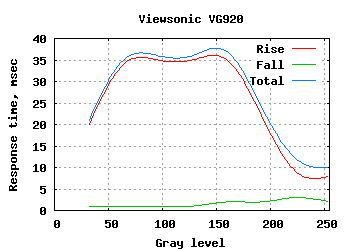LCD MONITOR REVIEW VIEWSONIC VG920 19 INCH
![]()
|
|
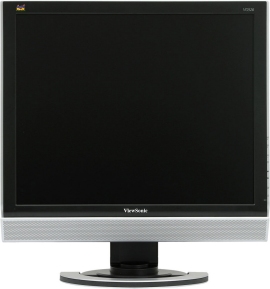 |
||||||||||||
| Posted:2006-07-08 By lcd monitor Number of View:20181 |
|||||||||||||
By :lcd monitor Posted:2006-07-08
ViewSonic VG920ViewSonic positions its entire VG series as LCD lcd monitors for processing complex graphics and for playing games. The positioning is strange in both respects. For example, the VG920 model uses a TN+Film matrix without response time compensation which makes it an equally poor choice for processing graphics and for playing dynamic games. The manufacturer touts the 8ms matrix as being very fast, but we know that this 8 milliseconds is only achieved on black-to-white transitions on TN+Film matrixes. Only RTC-capable lcd monitors are really fast, but their specified response is 2 or 4 milliseconds, but not 8 (by the way, the number alone is an indication that the VG920 lacks response time compensation).
The lcd monitor’s appearance is modest, yet eye-pleasing. The case is painted a matte black with silver speakers underneath. The panel with the speakers is slanted in such a way that they are facing downward at an angle (it can be seen more clearly in the next snapshot). This is of course wrong from the point of view of “serious” acoustic systems (speakers have a directional diagram of their own), but with the sound quality the lcd monitor’s speakers provide it is indeed unimportant where they are directed at. Such speakers are only good for reproducing the simple sounds from Windows, ICQ, etc.
The base allows changing the tilt of the screen and turning the lcd monitor around its vertical axis. With its rather limited functionality it is at least differs visually from the clumsy and tall stands of some low-end lcd monitors from ViewSonic, e.g. the VX724 and VX924 .
The lcd monitor has an integrated power adapter, analog and digital inputs, and an audio input. It lacks a headphones output.
It’s not very easy to control this lcd monitor. The onscreen menu remembers the option you changed last, but this is the only good point about it. The buttons are made not very well. It’s hard to sense them by the touch. The Down button is placed above Up for some reason. The Menu/Exit and Select buttons are traditionally for ViewSonic labeled as “1” and “2”, which only adds more confusion. Quick access is provided to the brightness and contrast settings (the Up and Down buttons), to sound volume adjustment and to switching between the inputs (the “2” button). By default, the brightness setting is set at 100% and the contrast setting at 70%. 50% of brightness and 55% of contrast yield 100-nit brightness of white. Color gradients are reproduced well on this lcd monitor with artifacts barely visible at any brightness/contrast settings. On the other hand, some fuzziness, a sort of noise, can be seen in certain halftones. It is not easily visible, but it’s there. This is probably a defect of dithering (Frame Rate Control, to be exact) because the lcd monitor uses an 18-bit matrix and produces 24-bit color through emulation.
The lcd monitor reproduces the full range of color tones at its default settings, but the gamma value is obviously too low, making the image look pale and unsaturated.
The curves straighten up at the reduced brightness/contrast, but the lcd monitor begins to lose some of the darkest tones: the gamma curves meet the X-axis in the bottom left of the diagram not exactly in the point (0.0), but on the left of it. At these settings (55% contrast) the lcd monitor cannot reproduce about 15-17% of the color range (i.e. these tones are all displayed the same as pure black). This defect is going to aggravate on further reduction of contrast.
The VG920 features a rather accurate color temperature setup. The sRGB mode should be a little colder than 6500K, but that’s the only thing I can cavil at here.
So, my words about the VG920 lacking response time compensation are confirmed by the tests. The graph shows a typical old TN+Film matrix for which the declared response time has little to do with the real speed. The matrix’s speed is fluctuating around 35 milliseconds through nearly the entire range of transitions, but then drops suddenly on the black-to-white transition to enable the manufacturer to declare a low response in the specs. But few users will ever happen to experience this speed in practice. I want to remind you that white color means the maximum value the matrix (not the lcd monitor!) can receive via its digital interface, not the signal the graphics card outputs! In other words, this pure white color can only be achieved if you’ve selected the highest possible contrast setting in the lcd monitor’s menu. But real lcd monitors are hardly ever used with this kind of setup, so you won’t be wrong to assume that the response time of this lcd monitor is closer to 30 rather than to 8 milliseconds.
The contrast ratio is good. It is lower than Samsung lcd monitors have, but above average nonetheless. The maximum brightness of 250 nits is quite high for a PC lcd monitor, too. Note also that the measured brightness is quite close to the specified value. Thus, the “lcd monitor for games and processing complex graphics” positioning of the VG920 doesn’t seem to have a solid base. It is an ordinary inexpensive 19” model with a slow matrix, average setup quality and unimpressive design. This lcd monitor will do well as an office model, but I wouldn’t recommend purchasing it as a gaming lcd monitor. It is many times slower than the new models with response time compensation, which you should consider first.
we would be happy to answer for your question . if you have suggestion or comment
regarding this review our support would be glad to help just join our forum and ask u will get the best answer
to discuss check our forum section :-) RATE THIS REVIEW | |||||||||||||
![]()

7600gt review
7600gt is the middle card range.
We already benchmarked this video card and found that ...

 geforce 8800gtx and 8800gts
geforce 8800gtx and 8800gts  Xtreview software download Section
Xtreview software download Section  AMD TURION 64 X2 REVIEW
AMD TURION 64 X2 REVIEW  INTEL PENTIUM D 920 , INTEL PENTIUM D 930
INTEL PENTIUM D 920 , INTEL PENTIUM D 930  6800XT REVIEW
6800XT REVIEW  computer hardware REVIEW
computer hardware REVIEW  INTEL CONROE CORE DUO 2 REVIEW VS AMD AM2
INTEL CONROE CORE DUO 2 REVIEW VS AMD AM2  INTEL PENTIUM D 805 INTEL D805
INTEL PENTIUM D 805 INTEL D805  Free desktop wallpaper
Free desktop wallpaper  online fighting game
online fighting game  Xtreview price comparison center
Xtreview price comparison center 

- The new version of GPU-Z finally kills the belief in the miracle of Vega transformation
- The motherboard manufacturer confirms the characteristics of the processors Coffee Lake
- We are looking for copper coolers on NVIDIA Volta computing accelerators
- Unofficially about Intels plans to release 300-series chipset
- The Japanese representation of AMD offered monetary compensation to the first buyers of Ryzen Threadripper
- This year will not be released more than 45 million motherboards
- TSMC denies the presentation of charges from the antimonopoly authorities
- Radeon RX Vega 64 at frequencies 1802-1000 MHz updated the record GPUPI 1B
- AMD itself would like to believe that mobile processors Ryzen have already been released
- AMD Vega 20 will find application in accelerating computations
- Pre-orders for new iPhone start next week
- Radeon RX Vega 57, 58 and 59: the wonders of transformation
- ASML starts commercial delivery of EUV-scanners
- The older Skylake processors with a free multiplier are removed from production
- Meizu will release Android-smartphone based on Helio P40
- AMD Bristol Ridge processors are also available in American retail
- The fate of Toshiba Memory can be solved to the next environment
- duo GeForce GTX 1080 Ti in GPUPI 1B at frequencies of 2480-10320 MHz
- New Kentsfield overclocking record up to 5204 MHz
- Lenovo released Android-smartphone K8



computer news computer parts review Old Forum Downloads New Forum Login Join Articles terms Hardware blog Sitemap Get Freebies


